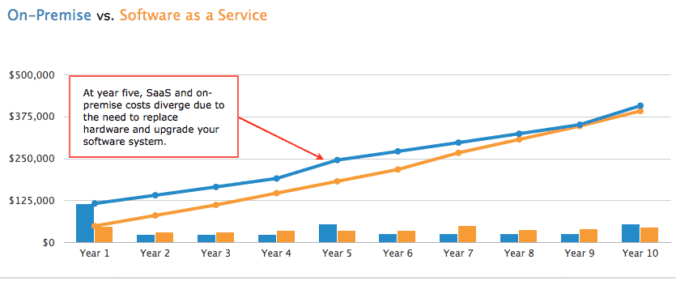Software as a Service (SaaS) gives businesses the flexibility to achieve what they need without the burden of paying for and maintaining a server on-premises. We explore the benefits of deploying a SaaS model with a cloud-based field service app.
Like any business, field service organizations are concerned with improving business performance, productivity in the field, and customer satisfaction. Field service management software is essential in order to access customer data, provide better customer service, and increase sales. Businesses looking to invest in or switch software platforms have a lot of tough decisions to make; a major one is whether to deploy software in the cloud or on-premises.
With growing advancements in cloud-based technology, Software as a Service (SaaS) deployment is emerging as a best practices for companies looking for the most functionality at the lowest Total Cost of Ownership (TCO). Even organizations currently using On-Premises solutions are realizing that the SaaS delivery model holds promise for lowering operating costs and reducing service maintenance stress.
Understanding your Deployment Options
- Software-as-a-Service (SaaS)
Software-as-a-Service (SaaS) is a web-based software maintained and managed by an external service provider, accessible via the internet. The SaaS delivery model is rapidly gaining traction because it offers faster deployment speeds, lower upfront costs, and ongoing flexibility to scale up or down as company needs change. SaaS vendors also provide regular scheduled maintenance and software upgrades with little to no involvement from the end-user. Because SaaS solutions have subscription-based licensing, they typically have little or no up-front cost.
- On-Premises
On-Premises solutions are installed and hosted in-house on your own data center and managed by your internal IT staff. On-Premises deployments are typically purchased with a larger up-front investment, and though it doesn’t require incremental costs throughout your ownership, it does require regular service and maintenance expenses from your IT department. It’s often difficult on the IT team to manipulate existing on-premises solutions to support new applications, integrations, and updates.
Selecting the Best Approach: Considerations for Service Firms Weighing a Cloud-Based Field Service App
Deciding how to deploy the software system that will run your business is a tough decision. Here are some benefits to weigh if you’re considering a SaaS model.
- Lowers Total Cost of Ownership (TCO)
Subscription based licensing (monthly, annually, multi-year) requires less up-front cost than an On-Premises deployment and offers alternatives to companies with small IT staffs or organizations looking to lower their operational costs. With SaaS, the vendor installs and integrates the software and manages all system maintenance including software upgrades, server support and data backup/recovery with no hardware or software setup on-site.
On-Premises deployment requires a larger up-front cost, but fewer incremental fees. The kicker, however, is that initial deployment and ongoing maintenance of an on-premises system requires extensive support from your IT department. Don’t underestimate the incurred expenses such as hardware, maintenance fees, IT labor and system upgrades you’ll need to swallow with an on-Premises deployment model.
- Total Cost of Ownership Calculator (TCO)–To help companies make a decision to fit their individual needs, Software Advice developed a tool to help software buyers compare the TCO between on-premises and SaaS systems. This Total Cost of Ownership Calculator (TCO) is aimed to help software buyers easily create a 10 year, apples-to-apples, price comparison of each software deployment model specific to their organizational needs.
- Eases Customizations and Integrations
SaaS vendors provide services in addition to their software. Because of its flexible API economy, cloud-based infrastructure enables simpler integration between field service apps and other enterprise software like ERP and CRM systems. Even a strong IT team can’t be experts in everything. When you work with a SaaS provider of field service software, you know they’re experts in their own application, so it’s easier for them to make the customizations and integrations to fit your company’s needs, allowing your internal team to focus on other priorities.
- Lessens Pressure on IT Staff
The capabilities and resources of an organization’s IT department will play a large part in the decision to implement a SaaS or Oon-premises solution. An IT staff may have the ability to handle software glitches and perform software updates, but ultimately management must decide if the IT department has the expertise and capabilities to install, configure, support, and manage an On-Premises solution. Cloud-based solutions ease the burden on your IT department and offer real-time support and automatic upgrades.
- Improves Security
It is essential for businesses of all sizes to secure their data in a centralized location, allowing important information to be backed up and accessed in case of network failure. Unless you have an IT department large enough to devote its time, effort, and resources to protecting your company’s data, it may make sense to host with a SaaS provider. With SaaS solutions, data is hosted off-site where vendors can apply security policies and continually track emerging threats to your information. In the case of equipment failure or a network crash, failover capabilities will ensure you don’t have any down time, and hosting data off-site will increase the chances of data recovery.
- Speeds Deployment
According to a study in Field Technologies Field Mobility 2014, “Twenty-five percent of survey respondents are using a cloud-based solution. And, 56 percent more are considering a cloud-based solution in 2014…the trend toward the cloud is overwhelming…The #1 reason our respondents picked cloud-based? Faster deployment.”
With faster deployment and lower maintenance expenses, businesses running field service management in the cloud are able to get up an running with lower up-front cost, so they can start improving service operations right away.
Pass Savings to Customers with a Flexible Solution that Scales with Business Needs
With the rise of cloud computing in the field service industry, many organizations are opting to host their software solutions off-site. For many companies, the switch to a cloud-based SaaS model eases the burden on IT departments by allowing providers to offer support and maintenance to its users.
By packaging the application software, IT infrastructure, and services together in a Web-based, multi-tenant subscription model, cloud computing vendors have the ability to contain variable costs more effectively than on-premises software vendors. And the best part: they can pass these savings along to customers, providing better service at a more affordable price. With the growing capabilities and security of the cloud, SaaS business solutions can help organizations provide added flexibility to scale as business demands require.
Cloud 101: A Buyer’s Guide to Managing Field Service in the Cloud

As SaaS deployment models continue to gain in popularity, you’ll want to know what questions to ask to potential vendors. Use this guide to prepare you and your team for a transition to cloud-based field service management.
Post updated from June, 2013









